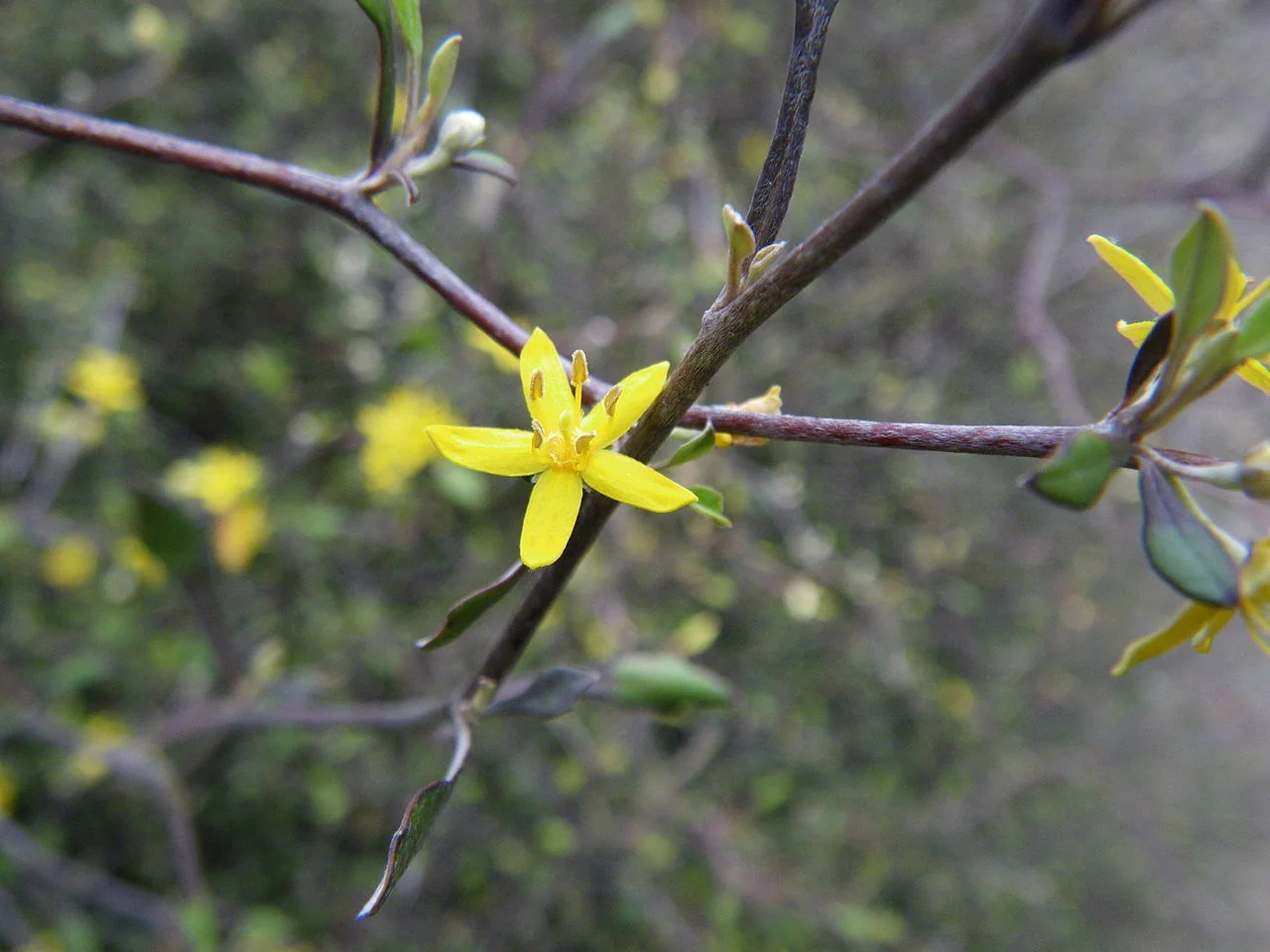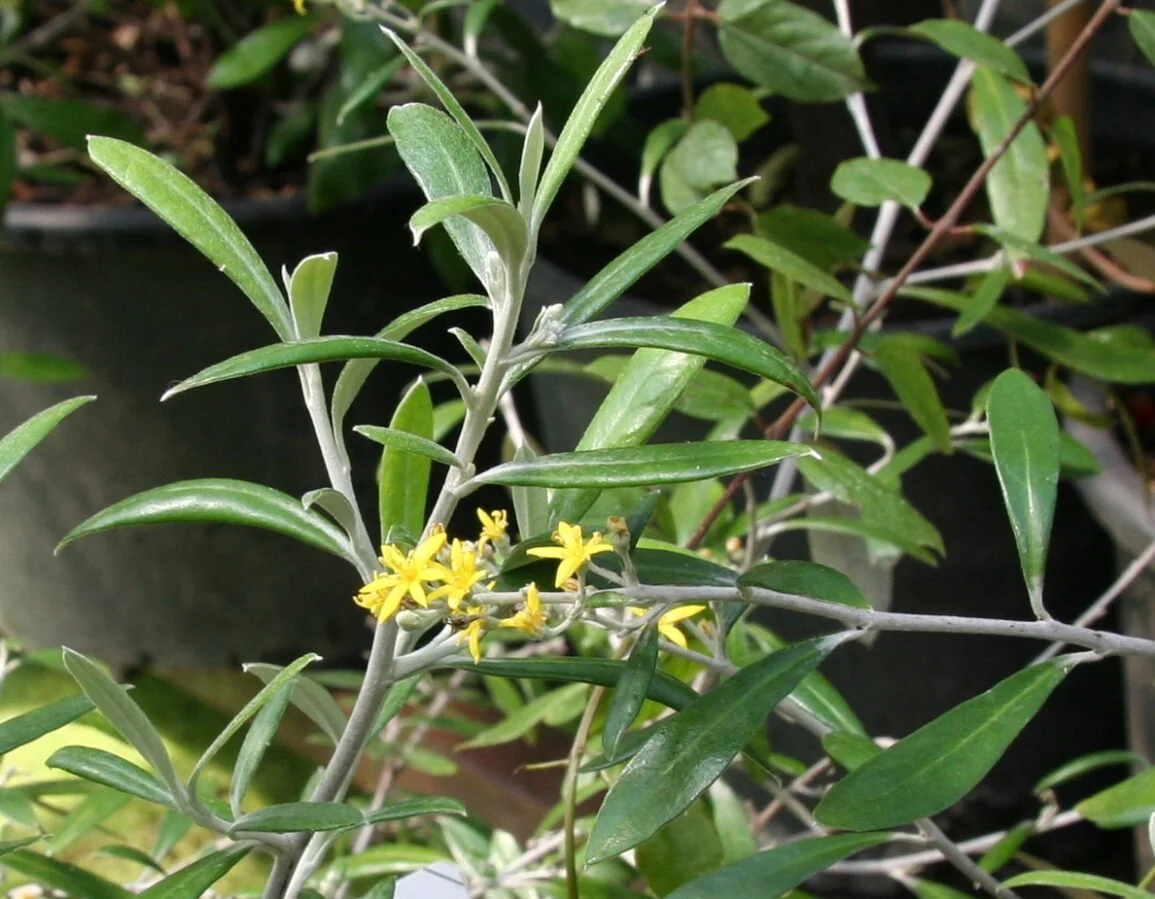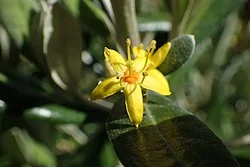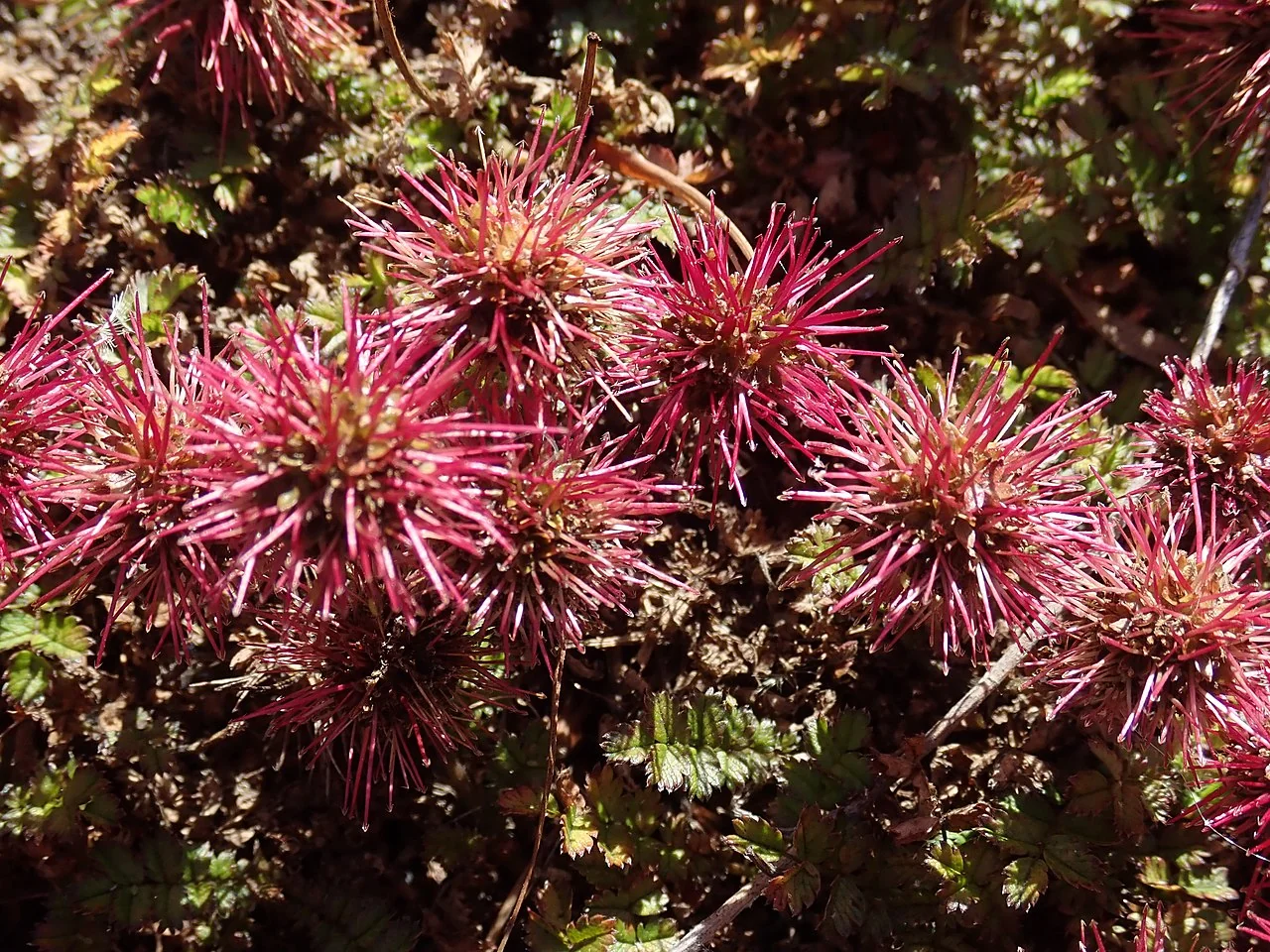
Wire-Netting Bush
Corokia cotoneaster
Corokia cotoneaster , commonly known as the wire-netting bush, korokio, or korokia-tarango, is an evergreen shrub among New Zealand's native shrubs native to New Zealand. It is characterized by its highly branched, strongly divaricating (wide-angled) habit, with rough, dark-coloured bark and distinctive thin, gray "zig-zag" twigs. It typically grows to about 3 meters (8-10 feet) in height and 2 meters (7 feet) in width, though it is slow-growing. Its unique branching pattern gives it a sparse, angular, and almost "smoky" appearance. The leaves are small and variable, ranging from obovate-cuneate to obovate-oblong, 2-15 mm long and 1-10 mm wide. They are dark or coppery green on top and often silvery-white underneath, with dented or rounded edges. It produces numerous small, star-shaped, bright yellow flowers, typically 5-8 mm in diameter. The flowers are followed by small, red, orange, or yellow drupes (fruits) that are 5-8 mm long. This plant is found in rocky, scrubby areas in New Zealand, from sub-alpine scrub to coastal cliffs. It is tolerant of dry conditions and prefers well-drained soil and full to filtered sun. Explore more in the native plants index .

Plant Description
Corokia cotoneaster , commonly known as the wire-netting bush, is an evergreen shrub native to New Zealand, recognized for its distinctive appearance and growth habit. It features a mass of interlaced, zig-zagging branches that are silvery when young and darken to brown with age. The leaves are small, dark green, broadly ovate, and often described as tiny with a silver-white underside. In spring and summer, the plant produces clusters of small, fragrant, star-shaped, bright yellow flowers. Following the flowers, it develops ornamental red, yellow, or orange berries. This is a slow-growing shrub, typically reaching an ultimate height and spread of 1.5 to 2.5 meters, taking 10-20 years to reach maturity. It thrives in full sun and well-drained soil, accommodating acid, alkaline, or neutral pH levels. It is generally hardy in many regions, but in colder climates, winter protection may be necessary. The plant is versatile and can be grown in gardens, containers, or even as a houseplant or bonsai.
Quick Facts
| Scientific Name | Corokia Cotoneaster |
|---|---|
| Height | 1-3 m |
| Spread | 1-3 m |
| Water Needs | Low |
| Light | Full sun to part shade |
| Frost Tolerance | Excellent |
| Salt Tolerance | Good |
| Growth Rate | Slow to moderate |
| Lifespan | Very long |
Climate Best Suited to
Wire-netting Bush ( Corokia cotoneaster ) thrives in well-drained, sunny positions and is tolerant of coastal conditions and wind. It adapts well to typical New Zealand growing conditions with appropriate care and positioning.
| Whangārei | Ideal |
| Auckland | Ideal |
| Hamilton | Suitable |
| Rotorua | Suitable |
| Tauranga | Ideal |
| Gisborne | Ideal |
| New Plymouth | Ideal |
| Whanganui | Ideal |
| Palmerston North | Suitable |
| Napier | Ideal |
| Wellington | Ideal |
| Nelson | Ideal |
| Christchurch | Suitable |
| Dunedin | Suitable |
| Invercargill | Suitable |
| City | Climate Suitability |
|---|
Natural Habitat
Corokia cotoneaster , the Wire-netting Bush, is an evergreen shrub endemic to New Zealand, widely distributed across the North, South, and Three Kings Islands. It thrives in diverse terrestrial zones, including dry to mesic scrub, forest margins, river-flats, and rocky sites, from coastal areas up to montane and sub-alpine zones. This hardy shrub prefers free-draining soils like sandy, loamy, or stony types, tolerating light clay if drainage is improved. It is notably tolerant of dry conditions, wind, and harsh weather, making it a resilient species in its natural environment.
Plant Conservation
Corokia cotoneaster is currently classified as "Not Threatened" by the NZPCN, a status it has maintained consistently across multiple assessments. This reflects its widespread distribution and resilience in various habitats. It is widely planted in both coastal and inland gardens, further contributing to its stable population. Its adaptability and hardiness ensure its continued presence in New Zealand's flora.
Growing Requirements
Soil Requirements
Prefers fertile, well-draining soil. It can tolerate various soil types (sandy, chalky, loamy) and a range of pH levels, but performs best in slightly acidic to neutral conditions.
Light Requirements
Prefers full sun to partial shade.
Water Requirements
Water when the soil is almost completely dry. Water thoroughly, ensuring moisture penetrates to the depth of the root ball. Reduce watering in winter.
Planting Guide
Best Planting Practices
Corokia cotoneaster is best planted in late spring or early summer. Choose a site with full sun to partial shade and well-draining soil. Dig a hole twice the size of the root ball and ensure the plant is well-watered before placing it in the hole. Backfill with soil, firming it down to ensure good contact with the root ball. Water thoroughly after planting and during dry periods for the first year.
Ecological Significance
The divaricating branches of Corokia cotoneaster provide a dense, protective habitat for small native birds, lizards, and invertebrates, shielding them from predators. The plant's flowers are a source of nectar for native pollinators, and its berries provide food for birds, aiding in seed dispersal. Its ability to thrive in harsh conditions makes it a valuable species for restoration projects and erosion control.
Uses and Significance
Garden Uses
- Excellent for native plant gardens and restoration
- Suitable for naturalistic landscape designs
- Low maintenance once established
- Contributes to local biodiversity
- Attractive to beneficial native wildlife
Cultural Significance
Corokia cotoneaster , also known as the wire-netting bush or korokio, holds significant cultural importance, particularly to the Māori people of New Zealand.
Traditional Uses:
- Tools and Weapons: The hard, wiry wood from its intertwined branches was historically fashioned into fish hooks and knives used for treating battle wounds or injuries.
- Ceremonial Uses: The leaves of korokio were also used in a ceremony to lift the tapu (sacred restriction) from foods.
- Fire Starting: Fine twigs of korokio served as tinder for making fires.
Medicinal Properties:
In Māori healing traditions, the leaves of korokio were boiled, and the cooled liquid was consumed as a tonic to treat stomach complaints and ulcers, with some accounts suggesting instant relief.
Symbolism and Aesthetics:
The "Māori Dance" variety of Corokia cotoneaster is noted for its zigzagging branches, which are said to resemble traditional Māori dance movements. Its unique form, with silver-grey leaves and silvery-white undersides, adds an "ethereal touch" and makes it a visually striking plant. Incorporating this plant into a garden can symbolize respect and appreciation for Māori traditions and heritage.
Landscaping Uses
Garden Design Applications
Corokia cotoneaster is a popular landscaping plant in New Zealand, valued for its unique form and resilience. It is often used for hedging and creating borders, as it tolerates regular clipping. Its dense, twiggy structure makes it an effective windbreak in coastal and exposed gardens. It can also be grown as a specimen plant, where its architectural form can be appreciated. Its suitability for topiary and bonsai is another reason for its popularity.
Seasonal Care Calendar
Spring
Fertilize with a balanced fertilizer to promote healthy growth.
Summer
Water regularly during dry periods, especially for young plants.
Autumn
Reduce watering as the weather cools.
Winter
Protect from cold, dry winds and extremely cold temperatures. Prune in late winter to maintain shape.
When to Prune and How Much
Pruning Details
Wire-netting Bush ( Corokia cotoneaster ) generally requires minimal pruning to maintain its natural form and health. Most maintenance involves removing dead or damaged growth and light shaping if needed.
- Remove dead, damaged, or diseased growth as needed
- Light pruning to maintain shape if desired
- Prune after flowering if applicable
- Avoid heavy pruning which can stress the plant
- Use clean, sharp tools to prevent disease
- Most natives maintain good form without regular pruning
Always use clean, sharp tools when pruning to minimize disease risk. Native plants typically maintain their natural form well and often require less intervention than exotic species.
How to Grow Wire-Netting Bush
From Cuttings
Propagate Wire-netting Bush ( Corokia cotoneaster ) effectively through semi-hardwood cuttings taken in late summer or early autumn. Select healthy, non-flowering shoots from the current season's growth, approximately 10-15 cm long. Remove the lower leaves, leaving only a few at the tip, and make a clean cut just below a node. Dip the cut end into a rooting hormone to encourage root development. Plant the prepared cuttings into a well-draining propagation mix, such as a blend of perlite and peat or sand. Ensure the cuttings are kept in a warm, humid environment, ideally under intermittent mist or covered with a plastic dome, to prevent desiccation. Provide bright, indirect light. Roots typically form within 6-12 weeks. Once rooted, gradually acclimatize the young plants to outdoor conditions before potting them into individual containers or planting them out in a sheltered location. This method ensures genetic consistency with the parent plant and is generally the most reliable way to reproduce the exact characteristics of the desired specimen.
From Seed
Propagating Wire-netting Bush from seed is also possible, though it can be a slower process and may result in some genetic variation. Collect ripe seeds from the small, red, orange, or yellow drupes in late autumn or early winter. Clean the seeds thoroughly to remove any fruit pulp, which can inhibit germination. Sow seeds in a well-draining seed-raising mix, lightly covered with fine grit. A period of cold stratification (e.g., 4-6 weeks in a refrigerator) can improve germination rates. Keep the seed tray consistently moist and provide bright, indirect light. Germination can be erratic and may take several months. Transplant seedlings once they are large enough to handle.
Pests and Diseases
Common Problems and Solutions
Corokia cotoneaster is generally a hardy plant with few pest and disease problems. However, it can be susceptible to root rot if grown in poorly drained soils. Overwatering can also lead to this issue. Mealybugs and aphids may occasionally be a problem, especially on new growth. Good air circulation and well-drained soil are the best preventative measures.
Bonus Tip
Expert Growing Advice
The divaricating branches of Corokia cotoneaster are an excellent example of a feature that is thought to have evolved as a defense against browsing by moa, the large, extinct birds of New Zealand.







